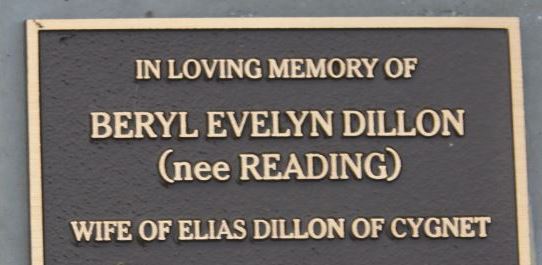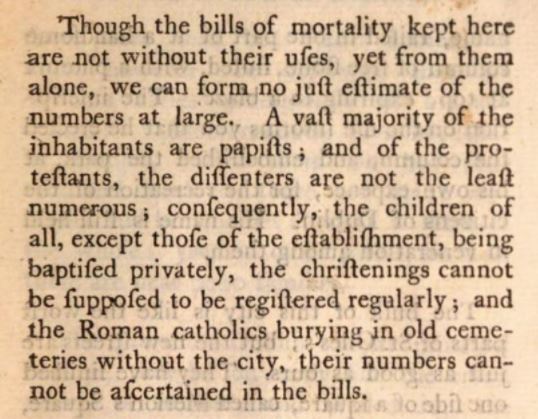
#52Ancestors Week 4 – Curious.
There are plenty of puzzles in my family tree. Despite all my efforts, Jane Leahy is still one of them.
Warning: this post is heavy on detail and more of a report than a general post.

Jane’s brief appearance in the records spans the seven years it took her to baptise five illegitimate children – 1839 to 1846.
The baptisms took place in the parish of Castletownroche. The father for all five was Henry Harrison Peard, and their address was given as Inchinapallas (aka Inchinapalace). Henry Peard’s death notice refers to him as ‘Henry H Peard of Inchinapallis’ so I think we can assume the two lived together.
That’s merely an assumption. Perhaps they didn’t. Perhaps Jane lived in a cottage on the property.
She was Irish Catholic and he was Protestant, but that didn’t truly stop people from marrying. It wasn’t very common, but it happened often enough. They were public enough that Jane could name him as the father for all the baptisms.
That said, did he even know he was publicly named? Was he present at those baptisms?
Here’s some geography. The world of Jane Leahy was a rather small triangle.

These towns and directions are pretty much to scale. Mallow, Fermoy and Mitchelstown form a triangle, Castletownroche and the townland of Inchinapallas are towards the centre south.
The Peards settled at Castlelyons near Fermoy somewhere around the 1640s (see Richard Peard-Adventurer or Gentleman?) and the ancestral property of Coole Abbey was passed down from eldest son to eldest son. They were comfortably off, not excessively wealthy. They weren’t titled. But they were landed gentry. They were educated, they travelled, they married into equally good families.
At least, some of them returned to Cork. I’ve not managed to trace the whole family.
As far as I can tell, our Henry Harrison Peard did not marry at all. He did not even marry the woman who gave him five children.
Why not?
There’s no indication that Jane could read or write. Castletownroche is six and a half miles from his home in Inchinappalas. I’m guessing she was a servant in Henry’s household and her parents were at Castletownroche. Would that be reason enough for him to not marry her?
Henry was aged about 25 when the eldest child John was baptised in Castetownroche. John was baptised on 26th June 1839, the 23rd child to be baptised that month.

For a while I wondered if he really was the father, but enough DNA matches have surfaced to confirm that he was. At least, to confirm that a Peard of that particular family was the father.
Henry Peard was heavily involved in efforts to alleviate the impact of poverty on the Irish poor. The 1830s and 1840s were peak years of the Irish famine. Whole families were starving to death, fever was raging, misery was everywhere.
Henry’s family spent the 1820s in St Helier. Coming back to Cork from somewhere like the Channel Islands must have given the whole family a shock. The locals had grown gradually into the tragedy, but Henry and his siblings did not grow up here. They saw it in all its catastrophic rawness.
It might be because he lived elsewhere that a relationship developed between Henry and Jane. He didn’t have the local prejudices of religion, class and education. He exerted himself hugely to deliver food to the poor, to seek out medical help, to find them places to live.
But he still didn’t marry Jane, and when he died in 1847 of a fever probably caught from those he was helping, no trace of her remained. She just vanished.
I don’t know how old she was. All I know is that she was childbearing age from 1839 to 1846. She might have been 15 in 1839. She might have been 40. We can’t even be sure of her name. Yes, she was Jane Leahy, but was that by birth or marriage? Perhaps she was a widow?
Here’s that ‘map’ with a couple more places marked.


Because we know so little about Jane, the best clue seems to be those baptism sponsors. Maybe they’re from Henry’s side, but if Henry’s family were happy to attend a local Catholic church for the baptism of Henry’s child among people who might have felt very bitter towards them with their good clothes and obvious health, then what possible impediment could there have been to the marriage??

At this point I’m puzzled that no child was named Henry.
It’s fairly common to name the first two boys after their grandfathers. We know that Henry Harrison Peard’s father was John Peard, so presumably young John was named after him. In that case, perhaps Jane’s father was Richard or William?
Whatever the naming system, we have three boys and none are named after their father. Why not???????????
Is there an elder child yet to find? Or did Henry perhaps already have a son named Henry with another woman?

The final children were baptised together after a four year gap. This doesn’t make them twins. There’s no indication of their age at this time. I’m guessing Ellen was older than Sarah.
A Look at the Sponsors
I’m sorry. This gets convoluted.

I’ll add one more record here: the baptism of Patrick Sullivan in April 1839 with what has to be our Jane Leahy as sponsor. She would have been pregnant with John at the time, although maybe not showing if he was her first.


Here are my findings:
Digitised baptisms for Castletownroche begin in 1811. Older people might simply be absent from searchable records.
Thomas Donovan – no baptism located in Castletownroche. A couple in the further reaches of the diocese of Cloyne. Two babies of this name were baptised in Castletownroche in the late 1820s, perhaps suggesting they had a common grandfather of that name?? But those two are too young to be sponsors for an 1839 baptism.
Margaret Leahy – many possibilities. There is a possible 1819 baptism in Castlelyons (Peard home ground) with parents John Leahy and Ellen Cosgrave who also have a daughter Jane baptised 1816. This couple is a hot contender as parents of our Jane, but the surname Cosgrave does not show AT ALL among the trees of my DNA matches so I can confirm nothing. It’s possible that Henry hired his servants from his home town to Inchinapallas and their whole extended families moved with them, hence the switch from Castlelyons church to Castletownroche. But this is purely conjecture. There are several Margaret Leahy’s showing as mothers to baptised babies in Castletownroche through the 1820s, 1830s and 1840s.
Eugene Mahoney – no baptism found in Castletownroche but a candidate located in Castlelyons, baptised 1820 the son of Denis Mahoney and Ellen Mara(?), sponsors John Eagan and Ann Kenny.
Margaret Donovan – A possible baptism in Castletownroche in 1813, daughter of John Donovan and Mary Scannel with sponsors Patrick Mahoney and Mary Keefe. There’s a marriage in 1840 in Castletownroche between Margaret Donovan and Denis Sullivan. Witnesses look to be Daniel Sullivan and Owen Donovan, but the handwriting is a bit hard to read.
Daniel Neill – two options: there’s a marriage in Castletownroche in 1822 between Daniel Neill and Margaret Buckley. There’s a baptism in Castlelyons 1814, to Michael Neill and Honora Sullivan. The person on the scene is always the most likely.
Bridget Hickey – this is very likely the wife of Bartholomew Connell of Castletownroche. Her children were born concurrently with Henry and Jane’s.
David Gay – Two generations, son David baptised 1822 in Castletownroche to David Gay and Mary Nagle (sponsors Andrew Casey and Catherine Neill). In 1840 a baby David Gay was baptised in Castletownroche to William Gay and Julia Sullivan of Inchinapallas. William seems to be another son of the earlier David and Mary.
Catherine Culnane – There are a spattering of Culnanes in the Castletownroche search results but nothing conclusive.
Michael Flahavan – baptised 10 Oct 1819, son of Martin Flahavin and Jane Casey of Inchinapallas. There’s no doubt about this one. Sponsors to the birth were Ned Mahoney and Catherine Hickey. I can’t find a marriage, but from 1841, a Martin Flahavin and Margaret Donovan of Inchinapallas were baptizing children, including a daughter Johanna.
Margaret Sullivan – many possibilities, none certain.
Michael Sullivan – Michael Sullivan and Mary Sheahan lived at Inchinapallas. Their son Denis was baptised in 1834 and one of his sponsors was Michael Flahavan. I can’t find a marriage.
Patrick Sheahan – I think this Patrick might be the one baptised 08 Oct 1815 to William Shehan and Jane Keefe, living at Templenoe. Several of the Mary Sheahans that I looked at were in Templenoe. But I really am not sure.
Conclusions
This hasn’t helped me locate Jane, but it has shown a community.
The place was obscure, even by Cork standards. It rarely appears on 19th century maps or travel guides. The closest I’ve found is Ballyhooly which is equally obscure.

Several families lived at Inchinapallas. These included the Sullivans, the Gays, the Mahoneys and the Flahavens, as well as our Jane Leahy and Henry Harrison Peard. There’s no indication that the sponsors of Henry and Jane’s children were family; they were probably just the other families in the same location. Friends.
The same surnames are scattered throughout the diocese, so there’s nothing to be learned there, and many records are illegible. It’s probably worth the time it would take to scour the parish records by hand and pluck out all the families of Inchinapallas – that’s a project I might undertake one day. But for now I’ll continue to explore the possibilites of DNA matching.
Through looking at the families of Inchinapallas I can see who Jane’s children played with; who their neighbours were. I don’t know if they continued in that place after Henry’s untimely death in 1847. I don’t know what his death meant to all the families there.
And so concludes this post: the curious absence of facts about Jane Leahy continues unabated.

























